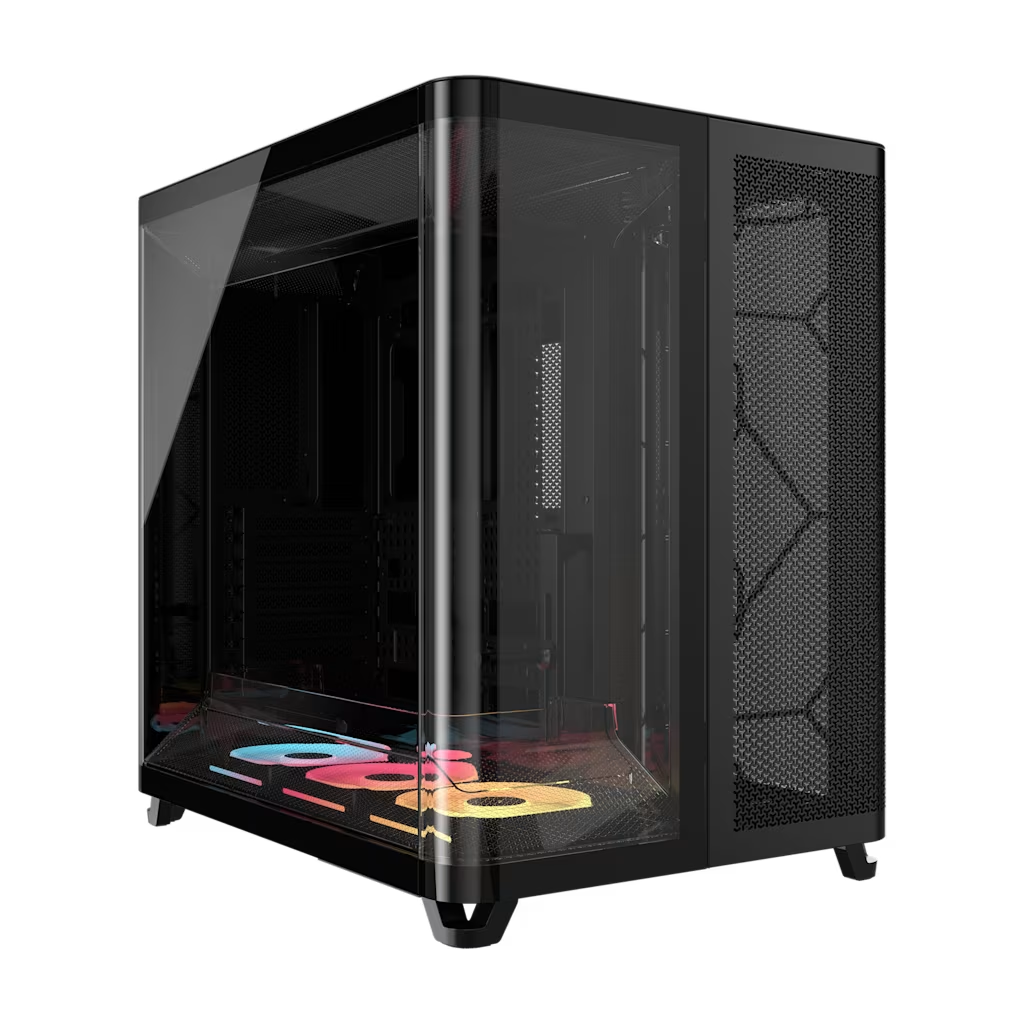Corsair AIR 5400: Redefining Case Design for the Next Generation of Gaming PCs

For years, PC cases have been caught between two worlds — function and flash. Builders wanted the sleek, glass-heavy designs with bright RGB, while enthusiasts cared more about airflow, thermals, and build practicality. But as GPUs and CPUs have grown hotter and more power-hungry, good looks alone no longer cut it.
That’s where Corsair’s new AIR 5400 comes in. It’s not just another airflow case; it’s a complete rethink of how internal components interact thermally. With its three-chamber layout, the AIR 5400 focuses on cooling efficiency, noise reduction, and ease of building — without sacrificing aesthetics.
The Triple-Chamber Revolution
Traditional cases follow a single-chamber layout, with one airflow path trying to cool everything — CPU, GPU, VRMs, storage, and PSU — all at once. The AIR 5400 abandons this entirely, opting instead for three independent zones.
Each chamber isolates a set of components:
- Main chamber: CPU, motherboard, and RAM
- GPU chamber: Graphics card(s) with dedicated intake and exhaust
- Rear chamber: PSU, cables, and storage drives
This separation allows airflow to target each zone directly, dramatically improving thermal efficiency. Hot air from the GPU doesn’t interfere with CPU cooling, and cable clutter doesn’t block intakes.
In testing, setups using this architecture showed temperature drops of up to 8°C under heavy load compared to equivalent single-chamber mid-towers. The benefit isn’t just lower temperatures — fans don’t need to ramp up as often, so the system stays quieter during gaming sessions.
Thermal Engineering in Practice
The AIR 5400 isn’t just about separating components — it’s about controlling airflow with precision. The front chamber draws cool air directly into the GPU area using reverse-rotor intake fans, while the CPU area benefits from a dedicated top and rear exhaust path.
This design creates pressure-balanced airflow, reducing turbulence inside the chassis. In other words, air moves more predictably and efficiently, which is why temperatures stay stable even under sustained load.
The case also supports large 360 mm radiators in both the front and top positions, with multiple fan mount configurations for fine-tuned cooling setups. Builders running high-end GPUs like the RTX 5090 or RX 9070 XT can benefit from direct intake cooling that feeds the card fresh air rather than recycled system heat.
Build Experience and Modularity
Corsair clearly designed the AIR 5400 for builders who like to get hands-on. The case features:
- Hinged tempered-glass side panels with tool-free access
- RapidRoute 2.0 cable management for easy routing behind the motherboard tray
- Full support for reverse-connector motherboards, making for cleaner cable layouts
Inside, there’s ample room for radiators, pumps, and reservoirs for custom loops. Corsair even added adjustable GPU brackets that can handle triple-slot GPUs without flex. Despite the multi-chamber design, it doesn’t feel cramped — building in it feels closer to working in a large dual-chamber workstation tower.
Storage support is also strong, with room for up to four 2.5" SSDs and two 3.5" HDDs, and clever cable routing to keep airflow unrestricted.
Real-World Use
The AIR 5400 isn’t just about numbers — it’s about experience. Builders have reported significantly quieter operation at load, especially when pairing it with modern GPUs that use semi-passive cooling modes.
Because the GPU chamber receives dedicated airflow, cards like the RX 9070 XT and RTX 5080 Super can sustain higher boost clocks for longer, even in extended gaming sessions. For water-cooling enthusiasts, the clear separation of chambers makes tubing routes simpler and more visually balanced.
At idle, noise levels hover around 25 dBA, and even under load with multiple fans running, it rarely exceeds 35 dBA. That’s whisper quiet compared to many high-airflow cases, which often sacrifice acoustics for performance.
The Technical Bits
Here’s a breakdown of what the AIR 5400 brings in real numbers:
- Dimensions: 520 mm x 245 mm x 520 mm
- Motherboard support: ATX, E-ATX, Micro-ATX, Mini-ITX
- Fan support: Up to 10 x 120 mm or 8 x 140 mm fans
- Radiator support: 3600 mm (top and front), 360 mm (side)
- GPU clearance: Up to 450 mm
- CPU cooler clearance: Up to 190 mm
- PSU support: Up to 250 mm (rear chamber)
These figures show that this isn’t just an airflow case — it’s a chassis built for future components. There’s enough space and cooling flexibility to handle next-gen CPUs and GPUs for years to come.
Final Thoughts
The Corsair AIR 5400 feels like the start of a new design philosophy. Instead of trying to be flashy or minimalist, it’s unapologetically practical — designed around airflow science and thermal independence.
It takes lessons from workstation and server cooling, refines them, and applies them to gaming PCs. And the result is something that performs as good as it looks.
As modern GPUs continue to push past 400 watts of power draw, this kind of design is no longer just a luxury — it’s a necessity.
The triple-chamber layout, modular build features, and Corsair’s refined engineering make the AIR 5400 one of the most forward-thinking cases available today. Could this be the future of PC cases?
Tarl @ Gamertech

